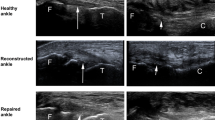Abstract
The modified Brostrom procedure is commonly recommended for reconstruction of the anterior talofibular ligament (ATF) and calcaneofibular ligament (CF) with an advancement of the inferior retinaculum. However, some surgeons perform the modified Bostrom procedure with an semi-single ATF ligament reconstruction and advancement of the inferior retinaculum for simplicity. This study evaluated the initial stability of the modified Brostrom procedure and compared a two ligaments (ATF + CF) reconstruction group with a semi-single ligament (ATF) reconstruction group. Sixteen paired fresh frozen cadaveric ankle joints were used in this study. The ankle joint laxity was measured on the plane radiographs with 150 N anterior drawer force and 150 N varus stress force. The anterior displacement distances and varus tilt angles were measured before and after cutting the ATF and CF ligaments. A two ligaments (ATF + CF) reconstruction with an advancement of the inferior retinaculum was performed on eight left cadaveric ankles, and an semi-single ligament (ATF) reconstruction with an advancement of the inferior retinaculum was performed on eight right cadaveric ankles. The ankle instability was rechecked after surgery. The decreases in instability of the ankle after surgery were measured and the difference in the decrease was compared using a Mann–Whitney U test. The mean decreases in anterior displacement were 3.4 and 4.0 mm in the two ligaments reconstruction and semi-single ligament reconstruction groups, respectively. There was no significant difference between the two groups (P = 0.489). The mean decreases in the varus tilt angle in the two ligaments reconstruction and semi-single ligament reconstruction groups were 12.6° and 12.2°, respectively. There was no significant difference between the two groups (P = 0.399). In this cadaveric study, a substantial level of initial stability can be obtained using an anatomical reconstruction of the anterior talofibular ligament only and reinforcement with the inferior retinaculum. The modified Brostrom procedure with a semi-single ligament (Anterior talofibular ligament) reconstruction with an advancement of the inferior retinaculum can provide as much initial stability as the two ligaments (Anterior talofibular ligament and calcaneofibular ligament) reconstruction procedure.






Similar content being viewed by others
References
Brostrom L (1966) Sprained ankles. VI. Surgical treatment of “chronic” ligament ruptures. Acta Chir Scand 132:551–565
Chrisman OD, Snook GA (1969) Reconstruction of lateral ligament tears of the ankle. An experimental study and clinical evaluation of seven patients treated by a new modification of the Elmslie procedure. J Bone Joint Surg Am 51:904–912
Colville MR (1995) Reconstruction of the lateral ankle ligaments. Instr Course Lect 44:341–348
De Vries J, Struijs PA, Raaymakers EL, Marti RK (2005) Long-term results of the Weber operation for chronic ankle instability: 37 patients followed for 20–30 years. Acta Orthop 76:891–898
Gould N, Seligson D, Gassman J (1980) Early and late repair of lateral ligament of the ankle. Foot Ankle 1:84–89
Horibe S, Shino K, Taga I, Inoue M, Ono K (1991) Reconstruction of lateral ligaments of the ankle with allogeneic tendon grafts. J Bone Joint Surg Br 73:802–805
Karlsson J, Bergsten T, Lansinger O, Peterson L (1988) Reconstruction of the lateral ligaments of the ankle for chronic lateral instability. J Bone Joint Surg Am 70:581–588
Karlsson J, Bergsten T, Lansinger O, Peterson L (1989) Surgical treatment of chronic lateral instability of the ankle joint A new procedure. Am J Sports Med 17:268–273 Discussion 273–264
Karlsson J, Lansinger O (1993) Chronic lateral instability of the ankle in athletes. Sports Med 16:355–365
Kjaersgaard-Andersen P, Wethelund JO, Nielsen S (1987) Lateral talocalcaneal instability following section of the calcaneofibular ligament: a kinesiologic study. Foot Ankle 7:355–361
Krips R, Brandsson S, Swensson C, van Dijk CN, Karlsson J (2002) Anatomical reconstruction and Evans tenodesis of the lateral ligaments of the ankle Clinical and radiological findings after follow-up for 15 to 30 years. J Bone Joint Surg Br 84:232–236
Leach RE, Namiki O, Paul GR, Stockel J (1981) Secondary reconstruction of the lateral ligaments of the ankle. Clin Orthop Relat Res, pp 201–211
Lee K, Yang K, Bae S, Suh T (2002) Modified brostrom procedure without calcaneofibular ligament reconstruction for chronic ankle instability. J Kor Sports Med 20:209–214
Messer TM, Cummins CA, Ahn J, Kelikian AS (2000) Outcome of the modified Brostrom procedure for chronic lateral ankle instability using suture anchors. Foot Ankle Int 21:996–1003
Okuda R, Kinoshita M, Morikawa J, Jotoku T, Abe M (1999) Reconstruction for chronic lateral ankle instability using the palmaris longus tendon: is reconstruction of the calcaneofibular ligament necessary? Foot Ankle Int 20:714–720
Sammarco GJ, Idusuyi OB (1999) Reconstruction of the lateral ankle ligaments using a split peroneus brevis tendon graft. Foot Ankle Int 20:97–103
Sefton GK, George J, Fitton JM, McMullen H (1979) Reconstruction of the anterior talofibular ligament for the treatment of the unstable ankle. J Bone Joint Surg Br 61-B:352–354
Tohyama H, Beynnon BD, Pope MH, Haugh LD, Renstrom PA (1997) Laxity and flexibility of the ankle following reconstruction with the Chrisman-Snook procedure. J Orthop Res 15:707–711
Weber BG, Humfauer W (1969) Zur Behandlung der frischen fibularen Bandruptur und der chronische fibularen Bandinsuffizienz. Arch Orthop Unfallchir 65:251–257
Author information
Authors and Affiliations
Corresponding author
Rights and permissions
About this article
Cite this article
Lee, KT., Lee, J.I., Sung, K.S. et al. Biomechanical evaluation against calcaneofibular ligament repair in the Brostrom procedure: a cadaveric study. Knee Surg Sports Traumatol Arthr 16, 781–786 (2008). https://doi.org/10.1007/s00167-008-0557-3
Received:
Accepted:
Published:
Issue Date:
DOI: https://doi.org/10.1007/s00167-008-0557-3




